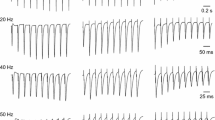Abstract
Field potentials (FP) induced in area C1 by gentle orthodromic stimulation were recorded in murine hippocampal slices and associative long-term potentiation (ALTP) produced by C2 tetanization associated with intensive tetanization of another group of fibers (C1) was investigated. A comparison was made between the effects of additional C1 tetanization produced at 50–300 msec before and after combined tetanization of both afferents. Where these intervals measured 50–200 msec, preliminary tetanization of C1 suppressed ALTP (rise in FP amplitude: 10.4±5.2%) in comparison with the regimen whereby additional C1 tetanization came later (giving a rise of 32.4±5.3%); no significant difference was noted at an interval of 300 msec. The three possible reasons for ALTP suppression are discussed, namely: inactivation of "fast" calcium channels, post-activation hyperpolarization of postsynaptic neurons, and synaptic inhibition. The ALTP suppression mechanism is thought to resemble that underlying the relative inefficacy of "reversible" combinations in the shaping of behavioral conditioned reflexes.
Similar content being viewed by others
Literature cited
L. L. Voronin, Plastic Properties of the Central Nervous System [in Russian], Metsniereba, Tbilisi (1982).
P. G. Kostyuk, Calcium and Neuronal Excitability [in Russian], Nauka, Moscow (1986).
B. I. Pakovich, "Conditions for formation of defensive motor conditioned reflexes," in: Central and Peripheral Mechanisms Underlying Motor Activity in Animals, Akad. Nauk, Moscow (1960).
D. A. Brown and W. H. Griffith, "Persistent slow inward calcium current in voltage-clamped hippocampal neurones of the guinea-pig," J. Physiol.,337, No. 1, 303–320 (1983).
J. H. Byrne, "Cellular analysis of associative learning," Physiol. Rev.,76, No. 1, 329–439 (1987).
S. S. Chirwa, S. W. Goh, H. Maretic, and B. R. Sastry, "Evidence for a presynaptic role in long-term potentiation in the rat hippocampus," J. Physiol.,399, No. 1, 41P-42P (1983).
G. L. Collingridge, S. J. Kehl, and H. McLennan, "Excitatory amino acids in synaptic transmission in the Schaffer collateral-commissural pathway of the rat hippocampus," J. Physiol.,334, No. 1, 33–46 (1983).
R. Dingledine, "N-Methyl-DL-aspartate activates voltage-dependent calcium conductance in rat hippocampal pyramidal cells," J. Physiol.,343, No. 1, 385–405 (1983).
T. V. Dunwiddie and G. Lynch, "The relationship between extracellular calcium concentrations and the induction of hippocampal long-term potentiation," Brain Res.,169, No. 1, 103–110 (1979).
J. W. Goh and B. P. Sastry, "On the mechanisms of long-lasting potentiation and depression of synaptically evoked responses in the mammalian hippocampus," in: Electrical Activity of the Archicortex," G. Buzsaki and S. H. Vanderwolf, eds., Acad. Kiako, Budapest (1985).
B. Gustafsson and H. Wigstrom, "Hippocampal long-lasting potentiation produced by pairing single volleys and brief conditioning tetani evoked in separate afferents," J. Neurosci.,6, No. 6, 1575–1582 (1986).
J. R. Hotson and D. A. Prince, "A calcium activated hyperpolarization follows repetitive firing in hippocampal neurones," J. Neurophysiol.,43, No. 2, 409–419 (1980).
W. B. Levy and O. Steward, "Synapses as associative memory elements in the hippocampal formation," Brain Res.,175, No. 1, 233–245 (1979).
J. Larson and G. Lynch, "Induction of synaptic potentiation in hippocampus by patterned stimulation involves two events," Science,232, No. 5, 985–988 (1986).
G. Lynch, J. Larson, S. Kelso, et al., "Intracellular injections of EGTA block the induction of hippocampal long-term potentiation," Nature,305, No. 5936, 719–721 (1983).
B. L. McNaughton, R. M. Douglas, and G. V. Goddard, "Synaptic enhancement in fascia dentata: cooperativity among coactive afferents," Brain Res.,157, No. 2, 277–293 (1978).
B. R. Sastry, J. W. Goh, and A. Auyeung, "Associative induction of post-tetanic and long-term potentiation in Cal neurons of rat hippocampus," Science,232, No. 5, 988–990 (1986).
R. W. Turner, K. G. Baimbridge, and J. J. Miller, "Calcium-induced long-term potentiation in the hippocampus," Neuroscience,7, No. 6, 1411–1416 (1982).
Additional information
Institute for Brain Research, Academy of Medical Sciences of the USSR, Moscow. Institute of Chemical Physics, Academy of Sciences of the USSR, Moscow. Translated from Neirofiziologiya, Vol. 21, No. 5, pp. 636–643, September–October, 1989.
Rights and permissions
About this article
Cite this article
Kleshchevnikov, A.M., Voronin, L.L. Suppression of associative long-term potentiation in the hippocampus after tetanization of reinforcing afferents. Neurophysiology 21, 452–457 (1989). https://doi.org/10.1007/BF01052877
Received:
Issue Date:
DOI: https://doi.org/10.1007/BF01052877



